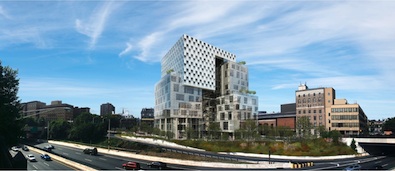University of Baltimore LEED Platinum Law School Building Under Way
 BALTIMORE — At the University of Baltimore, the first LEED Platinum-certified law school building in the country is on the way. Designers Behnisch Architekten of Stuttgart, Germany and Boston, Mass., in partnership with Baltimore’s Ayers/Saint/Gross, are developing the 190,000-square-foot John and Frances Angelos Law Center with sustainable features. Slated to open in spring 2013, the law center will serve students and facility with new technology and a greener environment.
BALTIMORE — At the University of Baltimore, the first LEED Platinum-certified law school building in the country is on the way. Designers Behnisch Architekten of Stuttgart, Germany and Boston, Mass., in partnership with Baltimore’s Ayers/Saint/Gross, are developing the 190,000-square-foot John and Frances Angelos Law Center with sustainable features. Slated to open in spring 2013, the law center will serve students and facility with new technology and a greener environment.
Fitting the 190,000-square-foot building within the compact site was one of several challenges the designers faced.
“It’s a triangular site which is a very unfortunate site for a building,” said Matthew Noblett, partner at Behnisch Architekten in Boston. “The building tended to stack up vertically and it required us to think a great length about how you circulate through the building, and how the elevator and stair connections would work inside the building.”
Noblett and the team paid special attention to the project’s mechanical and electrical components, since the building has exposed ceilings.
“There’s no ceiling cavity in which to hide ducts and pipes, so we had to be very careful about organizing all of them in a way that was still elegant even though the work was visible,” Noblett said.
The building is intended to serve as an example for how to create sustainable designs in an urban setting. Features include a rainwater-harvesting system that will capture and repurpose runoff and reduce overall water use; a green roof, terraces and a sunken garden with native and adapted plants; and nonemergency lights that automatically shut off after business hours.
“The Angelos Law Center will be an open, transparent building that is responsive to light and energy and whose design teaches critical lessons about how to create and sustain healthy urban environments,” said University of Baltimore President Robert Bogomolny.
The total energy savings, compared to an equivalent building without a LEED design, is estimated to be 46.5 percent, Noblett said.
One of the big cost-saving installations is the radiant system that conditions air. Tubing embedded in concrete carries hot or cold water throughout the building, which allows the concrete to in turn project the temperature into the rooms.
“It’s a much more comfortable way to condition the space because you don’t have drafts associated with blowing air and fans and you don’t have the noise associated with them either,” said Noblett. “It’s also a third of the cost of an equivalent fan driven system.”
All the offices and classrooms in the building have operable windows. The building also has a glass façade with exterior windows and solar shading devices for individual temperature control.
“The Angelos Law Center will provide interior spaces that connect people to the cycles of nature — light, air and water — and to other people in the building through ways that are not possible in our current space,” Bogomolny said. “Each level of the building will encourage interaction by linking students to faculty, further creating a healthy work and study environment that will redefine what it means to teach and to learn at the University of Baltimore.”
The building also boasts new technology. The center will have classrooms with 30 large and small group study spaces and a seven-floor digital library, in addition to a 300-seat moot courtroom, communal atrium, two coffee shops, four terraces and a private event space.
The current UB law facility opened in 1932. Since then, student enrollment has increased by more than 20 percent and faculty and support staff has more than doubled.
